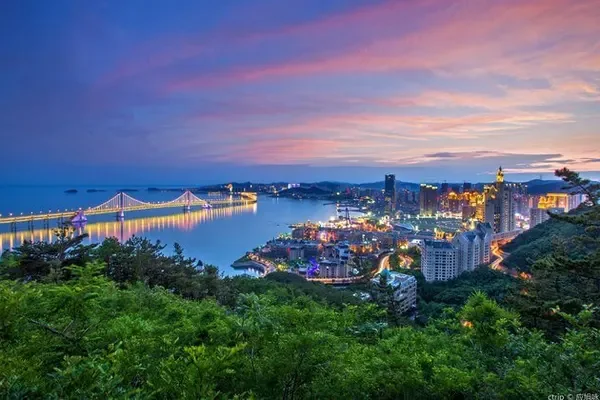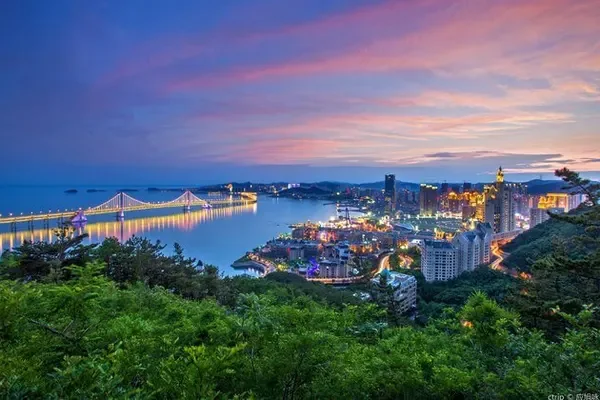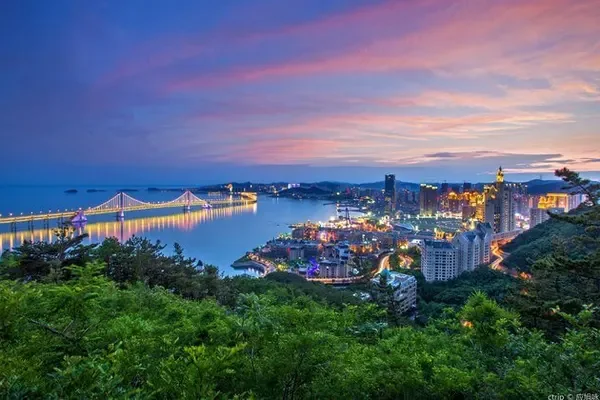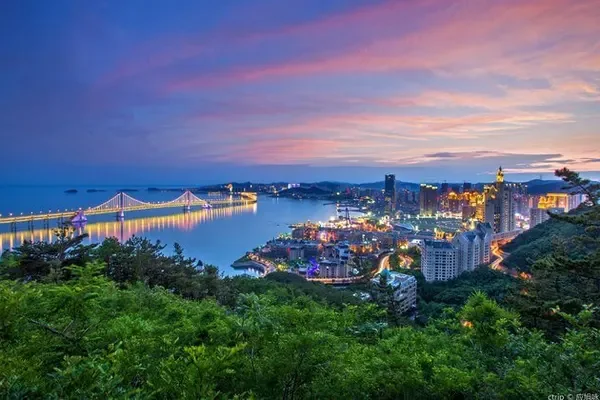foreword
For contemporary people, Shanxi is a province famous for its coal bosses, while others seem to be much more low-key. But since ancient times, Shanxi has been an important border of the Central Plains, retaining a piece of great rivers and mountains, and retaining a unique historical heritage. In this special year, it is the best choice to revisit the land of Sanjin, enjoy the culture of Jinfen, view Jinshan and Jinshui, and taste Jin cuisine.
On July 18, the plane finally landed slowly at Taiyuan Wusu Airport almost 2 hours late. Pick up the car at the airport and head straight to Mount Wutai. When driving into the Wutai Mountain area, there are many mountains and mountains, and the scenery of the northern country is in full view. At around five o'clock, I found a hotel not far from the mountain gate, unloaded my bags and went to a small shop nearby to have a simple dinner.

1. Wutai worship Buddha
On the morning of July 19th, after washing up early, it was triggered to Taihuai Town. Due to insufficient estimates, the team took half an hour to shoot at the gate of the mountain before driving into the scenic spot. There are about 13 companies from the mountain gate to the scenic spot. Fortunately, the road is not blocked, and finally arrived at Taihuai Town at 10 am. The sun was shining brightly, and the sky was as blue as washing. Wuye Temple and Tayuan Temple are very quiet under the blue sky.

Stepping into the Tayuan Temple, the Dabai Pagoda comes into view. Although it is a little mottled, it still cannot conceal its holiness and nobility. Around the Great White Pagoda, following several believers stroking the prayer wheel and walking around, it seems to hear the thousand-year-old Dharma echoing in the ears.

After seeing the Great White Pagoda, go straight to the top of the Bodhisattva. The Bodhisattva Peak is located on the Vulture Peak. The archway and yellow glazed tiles of Wutai Holy Land show the noble status of this yellow temple.

Come to the Qianmiao, overlooking the 108 steps, you can have a panoramic view of the entire Taihuai Town. The blue sky, green hills, and white pagoda are like a paradise, where you can enjoy a moment of peace and practice the thousand-year-old Dharma.

After four o'clock in the afternoon, I finished the trip to Taihuai Town and drove straight to Dongtaiding. The mountain road was winding and there were many sharp turns. Looking at the fuel gauge that kept falling, I was frightened, wondering if I could still browse the mountain, and finally reached the top of the mountain half an hour later.

The last time I came here, it was cloudy and rainy, and it was very cold. Although the temperature is a bit low today, the weather is fine. You can have a panoramic view of Dongtai and Mount Wutai.

On the side of the road is Dongtaiding Wanghai Temple. Devout believers park their cars on the side of the road and walk down to Dongtai. It is estimated that it will take an hour to walk there.

After driving past the top of the mountain, free-range cattle can be seen everywhere on the meadow, some are grazing on the hillside, some are walking in the middle of the road, and they are not afraid of vehicles at all.

After driving through the winding downhill road, half an hour later, I arrived at the foot of the mountain. A small stream flowed by the side of the road. I parked the car on the side of the road and washed my hands with the clear water. That cold feeling instantly reminded me of the creek behind my house, and the happiness of childhood in summer will always be accompanied by that creek.

I finally got on the expressway from the small road, passing through the battlefield of Pingxingguan Great Victory, and also contributed 200 points to Shanxi on the expressway, deducting 6 points.

After more than an hour's journey, we finally arrived at Hunyuan at 7 o'clock in the evening. After dinner, after tidying up a bit, I went to bed and rested to reserve energy for the next day's trip.
2. Entering the Buddha in Yungang
At 8 o'clock in the morning on July 20th, they departed from Hunyuan County on time and arrived at Xuankong Temple in more than 20 minutes. As a thousand-year-old temple, the Xuankong Temple is a unique temple that combines Buddhism, Taoism, and Confucianism. It is located among the cliffs of Mount Heng. When you reach the foot of the mountain, you can see the entire Xuankong Temple. This time I was lucky enough to board, the corridor was extremely narrow, and I could only pass sideways. Walking on it, the floor made a creaking sound, and my heart was somewhat nervous. Li Bai passed by here and couldn't help leaving behind two "magnificent".

After 2 hours, we left the Hanging Temple and headed towards the Yungang Grottoes. Finally arrived at Yungang Grottoes at 12 noon. Due to the need for an appointment, we did not enter the scenic spot until two o'clock in the afternoon. When you come to the first mountain gate of the grotto, the plaque in front of the gate is inscribed with the four characters "Entering the Buddha's Knowledge", and the couplet on both sides is "Seek the Dharma from the wisdom, and transform all living beings with compassion", which seems to tell the mediocre mortals to enter this gate to seek the Dharma. Transform all living beings.

After visiting the first twenty caves, each cave is different, and all the Buddha statues have their own characteristics, telling classic Buddhist stories one by one, and also telling the pursuit of Buddhist teachings by believers in the past dynasties.

After finishing the trip to Yungang Grottoes, we headed directly to downtown Datong. The Daqin Railway passed through the village. When I was a child, whenever a coal train passed by my house, I always wanted to go to the other side of the railway to see what Datong was like. After spending 1 hour, I finally arrived at the ancient city wall of Datong. I found that the ancient city has been well restored, and I can drive around the road directly under the ancient city to patrol the city. At night, looking down at the hotel, the ancient city wall and towers are decorated with lights.
3. Tracing Yanmen
"Nine fortresses in the world, Yanmen is the leader", starting from Datong at 9 am on July 21, heading straight for Yanmen Pass. Coming down from the Erguang Expressway, you have to drive a section of about 8 kilometers of national road. There are high mountains on both sides, and the national road is winding with many U-shaped bends. Finally arrived at Yanmen Pass at 11:00 noon.

Speaking of Yanmen Pass, I can't help but think of Qiao Daxia, who died here, very sad. As a border fortress, it is necessary to protect the safety of Taiyuan, and it is also an important border trade port.



The ancients transported goods from beyond the Great Wall to the Central Plains along this narrow path.

Exit from Yanmen Pass and head directly to Jinci Temple. It was already 5 o'clock in the afternoon when we arrived at Jinci Temple, so we didn't catch up with the time of the day. Had to live in Jinci Hotel. This is still highly recommended. It is close to Jinci Temple, the environment is quiet, and you can directly enter Jinci Temple, which is very convenient.
4. Visiting ancient times in Jin Temple
At 8:30 am on July 22, the Jinci Hotel was sent directly to the entrance of Jinci. The Jin Temple was originally the Tang Shuyu Temple, and later the Jin King Temple, the ancestral hall of the Jin Kingdom. Due to the early hours and relatively few people, we quickly passed the code inspection and entered Jinci Temple. Entering the Jinci Temple, the first thing you see is the water mirror platform, is it very similar to Sun Dasheng's transformation? On the back of the stage is the stage, facing the Notre Dame Hall.

Passing through the water mirror platform are the four bronze figures, and then the Duyue archway was built in the Wanli period of the Ming Dynasty. The plaque was inscribed by Gao Yingyuan, a calligrapher in the Ming Dynasty. "One sentence.

Crossing the Duiyue archway is the Hall of Dedication, which is a hall for storing tributes to the Virgin Mary. It is shaped like a turtle, implying a long life. The whole building is a wooden structure without a single nail. In front of the dedication hall, you can see a solemn and solemn hall, which is the Hall of the Virgin. Rare, it is one of the three treasures of Jinci ancient architecture. Walking across the Fish Marsh Feiliang Bridge, you will come to the most famous Notre Dame Hall in Jinci Temple. You can see eight wooden carvings of the Song Dynasty coiled on the eight pillars outside. After thousands of years, they are still clearly visible, and the angry eyes and sharp claws are lifelike. This is also a rare woodcarving of the Song Dynasty in China. Panlong boutique is also one of the three treasures of Jinci ancient architecture

On the right side of the Notre Dame Hall is a cypress tree from the Western Zhou Dynasty, 3,000 years ago, and it is one of the three treasures of the Jinci Temple.

On the left side of the Jinci Temple is the Nanlaoquan, but it is a pity that it is under repair this time, so it is hard to see the true face. You can only listen to the allusions of 37 points.

After finishing the tour of Jinci Temple, we went straight to the ancient city of Pingyao, and the journey only takes one hour.
5. Dreaming in Pingyao
This trip was in a hurry. I arrived at the ancient city of Pingyao at noon, entered from the south gate, and randomly chose a small shop for lunch. I wanted to go shopping in the afternoon, and then went to the Wang Family Courtyard later. But after eating, I saw that there were not many people in the ancient city, and there were more characteristics, so I decided to go directly to the Wang family compound for the time being, and then return to the ancient city of Pingyao to live in the evening.

It only takes one hour from the ancient city of Pingyao to the Wang Family Courtyard, and soon you will arrive at the Wang Family Courtyard.

The Wang Family Courtyard was built by the Jingsheng Wang family through the Ming and Qing dynasties, and it took more than 300 years to build it. It is divided into the Gaojiaya Building Complex and the Hongmenbao Building Complex. Among them, the Gaojiaya Building Complex has 35 large and small courtyards with as many as 342 houses. Between the large and small courtyards, there are 65 gates connected from top to bottom, left and right. The Red Gate Fort complex is built on the hillside, and is arranged in four-storey courtyards from low to high. The whole complex forms a very regular "king" character. , also implying the shape of a "dragon". All kinds of courtyards have their own characteristics, and none of them are the same.


The owner of the Wang family compound must have spent a lot of thought on the construction, and various details have different meanings, such as a relief sculpture in front of a door, all the way contains the imperial examination.

At five o'clock, I returned to the ancient city of Pingyao from the Wang Family Courtyard, checked into an inn that was rebuilt from a 400-year-old courtyard, and chose a kang room.




After a little tidying up, I went to the ancient city for a walk. At the beginning of the Chinese lanterns, there are not many people. Walking on the street is very pleasant, without the noise of the ancient town in the south of the Yangtze River.


6. View Waterfall in Hukou
On the morning of July 23, proceed from the ancient city of Pingyao to Hukou Waterfall. The distance is long, and after passing Linfen, the speed limit of the highway is 100, 80, which is really difficult to drive. At nearly 12 o'clock, I finally arrived at Hukou Scenic Area.

I have always heard that "the water of the Yellow River comes from the sky", but I have never seen "the Yellow River is roaring". When I stood by the Yellow River, I was deeply shocked by the surging water of the Yellow River, and let out a roar that shook the sky.



The time for Hukou Waterfall is not long. It departs from Hukou Waterfall to Changzhi around 3 o'clock. This is also the longest one-way section of this itinerary. It finally arrived in the urban area of Changzhi after 7 o'clock in the evening.
Seven, Taihang scenery
On the morning of July 24th, we set off from Changzhi City, and after driving for nearly two hours, we finally arrived at the Baquanxia Scenic Spot of Taihang Mountain. Walking in the valley along the way, the green hills on both sides are like knives, straight up and down, feeling that they may fall down at any time.

Eight hundred miles of Taihang, high mountains and flat lakes, the scenery is beautiful, and it takes a lot of physical strength to complete it.






Coming out of the scenic spot, it was already 6 o'clock in the evening, and the sky was still bright. After weighing again and again, I had to drive back to Taiyuan.
8. History of Jinbo
On the morning of July 25, it began to rain lightly. Fortunately, only the Shanxi Museum was arranged. After breakfast, we arrived at Shanxi Museum soon. The four-story exhibition hall displays the cultural history of Shanxi in different categories, which can be regarded as a summary and review of the 7-day itinerary.


Nine. Summary
This itinerary is quite tense, so take the Shanxi tourism traffic map and mark this itinerary to make a summary. In short, Jinshan and Jinshui are perfect, and Shanxi is a good place.




